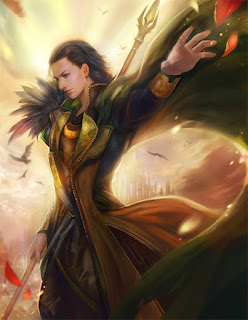Beware the Tricks of Loki
God of Mischief, Chaos and Change
Master of Magic and adept Shapeshifter
Harbinger of Ragnarok and Rebirth of the Worlds
What is it about Loki that has made him so very popular within Western culture when we want to be entertained by a troublemaker within our books and movies? Of all of the gods from the various pantheons that are out there, he seems to be one that has captured people’s imagination the most, and it started before Tom Hiddleston played him in Thor and The Avengers. Possibly it has a little bit to do with the fact that he is someone who is so closely associated with mischief and causing trouble. There are other figures that perform that function as well (like Puck, Anansi, or Coyote), but none of them seem to have latched onto our collective consciousness the same way that Loki has. But there also may be a bit of the fact that he is able to help people get out of trouble as well (though, he’s usually helping them get out of whatever sticky situation that he got them into in the first place).Like Tom Hiddleston’s version of the character, the mythological Loki is a complicated guy, whose allegiances are hard to pin down — but the similarities are pretty limited after that. Loki is sly, manipulative, charming, humorous, mischievous, quick to anger, and cruel. The Norse version of Loki is not Thor’s adopted brother but his friend, travel companion and maybe his fuck buddy. Also, while in early stages of Loki’s story he’s more mischievous than straight-up bad, his transition from puckish to evil takes place over time.
A sly, vengeful trickster who is always causing trouble among the gods, he is tolerated in Asgard only because of the great services he has performed in the past, such as helping to create Midgard and the wall guarding Asgard. He has mixed freely with the gods for a long time, even becoming Odin's blood brother. In his true form, Loki is a handsome young man who is always dressed in some combination of red and black.
Loki: He is everyone’s favorite now days, thanks to the more than stunning Tom Hiddleston, but I even like the real god. He really is not bad, per say. It is his job to mess stuff up and in any effect, he bails the gods out of so many issues its not even funny. He had sex with a horse for them!!! I mean, he killed Balder, but that legend taught a valuable lesson. Loki taught us beauty fades and even death will get those who are so dear and one can’t avoid or change their fate not even the gods. He showed us that even the mighty Thor knows humility when it comes to the safety of others. He also has to be the role model for lawyers. So, no I do not care, Loki rocks! Is Tom sexy? Hell yes he is. BUT Loki is supposed to be handsome, too. Also, Norse Loki is a redhead.
The whole thing sounds kind of bleak, but it has always seemed to me that figures like Loki have provided a necessary function. Without tricksters such as him, the world would become static and unchanging. I can hear you saying that there are innovators and revolutionaries, who serve much the same purpose, and they do so without causing all kinds of trouble or destruction, but that probably depends greatly on who you ask (and how their worldview is on who the “troublemakers” and “tricksters” really are).
Nature
The trickster character is a complex character, a master of guile and deception. Loki was not so much a figure of unmitigated badness as a kind of celestial con man. He would often bail out the gods after playing tricks on them, as illustrated by the myth in which he shears Sif's hair and then replaces it, or when he is responsible for the loss of Idunn's apples of youth and then retrieves them again. Loki is an adept shape-shifter, with the ability to change both form (examples include transmogrification to a salmon, horse, bird, flea, etc.) and sex.
His Children
Loki's children are powerful being that have power to aid or hinder the gods and mortals alike.








Comments
Post a Comment